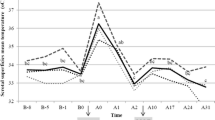Abstract
Undescended testis is a common problem leading to infertility. After orchiopexy some studies support the necessity of hormonal therapy. Electromagnetic field stimulation on living tissues increase cell proliferation, protein and DNA synthesis.Sixteen prepubertal rats was objected to the fixation of left testes to the anterior abdominal wall for 30 days, right testes were removed. Another group of sixteen rats objected only to the right orchiectomy and a manipulation simulating study group without fixation. After orchiopexy, animals were divided into two groups. Both groups had eight rats. Electromagnetic field (EMF) stimulation group had the stimulation for two hours every day for ten days, while the second group did not. The sham group also divided into two groups. The first one applied EMF and name as Group CEM, the second one was sham. Weight of removed testes were measured and fixed in 10% formaldehyde for histopathological evaluation. At the creating of undescended testis and right orchiectomies a blood sample was obtained for testosterone level of prepubertal rats. After finishing EMF stimulation the rats were mated with females for 17 days. After fertility study a blood sample was obtained for testosterone assay and body weight were measured and fixed in formaline for histopathologic evaluation. All the rats were killed with overdose ether anesthesia and number of fetuses were recorded. Histopathological evaluation was based on Johnsen criteria and seminiferous tubule diameter measurements.We conclude that EMF stimulation resulted in Leydig cell proliferation, increase in testosterone level, testis weight, but decrease in germ cell population.
Similar content being viewed by others
References
Christiansen P, Müller J, Buhl S, Hansen OR, Hoobolt N, Jacopsen BB, Jorgensen PH, Kastrup KW, Nielsen K, Nielsen LB, Pedersen-Bjergaard L, Petersen SA, Thamdrup E, Thited E, Tranebjaerg L, Skakkebaek NE. Hormonal treatment of cryptorchidism - hCG or GnRH - a multicentre study. Acta Paediatr 1992; 81: 605.
Christiansen P, Müller J, Buhl S, Hansen OR, Hoobolt N, Jacopsen BB, Jorgensen PH, Kastrup KW, Nielsen K, Nielsen LB, Pedersen-Bjergaard L, Petersen SA, Thamdrup E, Thited E, Tranebjaerg L, Skakkebaek NE. Treatment of cryptorchidism with human chorionic gonadotropin releasing hormone. Horm Res 1988; 30: 187.
Friedman RM, Lopez FJ, Tucker JA, King LR, Negro-Vilar A. Fertility after cryptorchidism: A comparative analysis of early orchiopexy with and without concomitant hormonal therapy in the young male rat. J Urol 1994; 151: 227.
Huff DS, Hadziselimovic F, McC Snyder III H, Blythe B, Ducket JW. Histologic maldevelopment of unilaterally cryptochid testes and their descended partners. Eur J Pediatr 1993; 152 (Suppl 2): S10.
Kiely EA. Scientific basis of testicular descent and management implications for cryptorchidism. BJCP 1994; 48(1): 37.
Güzelsu N, Salkind AJ, Shen X, Patel U, Thaler S, Berg RA. Effect of electromagnetic stimulation with different waveforms on cultured chick tendon fibroblasts, Bioelectromagnetics 1994; 15: 115.
McDonald F. Effect of static magnetic fields on osteoblasts and fibroblasts ivitro, Bioelectromagnetics 1993; 14: 187.
Abas?yan?k A, Yazgan E, Gökçora İH, Yücesan S. The effect of electromagnetic field on peritonitis treatment (Experimental Study). Turkish Journal of Pediatric Surgery 1991; 5: 77.
Dindar H, Renda N, Barlas M, Akinay A, Yazgan E, Tinçer T, Çakmak M, Konkan R, Gökçora İH, Yücesan S. The effect of electromagnetic field stimulation on corticosteroids-inhibited intestinal wound healing. Tokai J Exp Clin Med 1993; 18: 49.
Dindar H, Zeybek N, Yücesan S, Barlas M, Yurtaslan? Z, Yazgan E, Konkan R, Özgüner İF, Gökçora İH. Augmentation of mucosal adaptation following small-bowel resection by electromagnetic field stimulation in rats, Tokai J Exp Clin Med 1993; 18: 39.
Sadler TW. Urogenital system, Langman's Medical Embryology, 6th edition. Baltimore: Williams & Wilkins, 1990.
Carizza C, Antiba A, Palazzi C, Pistono C, Morana F, Alarcon M. Testicular maldescent and infertility. Andrologia 1990; 22:285.
Quinn FMJ, Crockard AD, Brown S. Secondary changes in the scrotal testis in experimental unilateral cryptochidisöm. J Ped Surg 1990; 25: 402.
Salman FT, Adkins ES, Fonkalsrud EW. Morphologic effects of orchiopexyor orchiectomy on the contralateral testis in experimental unilateral cryptorchidism. Surg May 1988: 573.
Lee PA. Fertility in cryptorchidism. Endocrinol Met Clin North Am 1993; 22: 479.
Job JC, Toublanc JE, Chaussain JL, Gendrel D, Garnier P, Roger M. Endocrine and immunological findings in cryptochid infants, Horm Res 1988; 30: 167.
Merksz M, Toth J, Pirot L. Testosterone secretion in children with undescended testis. Int Urol Nephrol 1992; 24: 429.
Hesse V, Fischer G. Three injections of human chorionic gonadotropin are as effective as ten injections in the treatment of cryptorchidism, Horm Res 1988; 30: 193.
Author information
Authors and Affiliations
Rights and permissions
About this article
Cite this article
Ozguner, I.F., Dindar, H., Yagmurlu, A. et al. The effect of electromagnetic field on undescended testis after orchiopexy. Int Urol Nephrol 33, 87–93 (2002). https://doi.org/10.1023/A:1014473407519
Issue Date:
DOI: https://doi.org/10.1023/A:1014473407519




